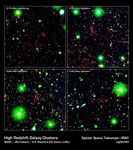
Click on image for poster
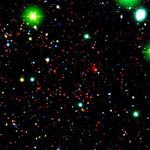 | 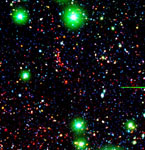 | 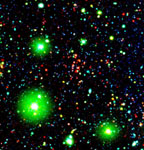 | 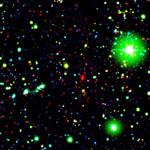 |
| 8.15 Billion Lightyears | 8.59 Billion Lightyears | 8.98 Billion Lightyears | 9.09 Billion Lightyears |
Like great friends, galaxies stick together. Astronomers using NASA's Spitzer Space Telescope have spotted a handful of great galactic pals bonding back when the universe was a mere 4.6 billion years old. The universe is believed to be 13.7 billion years old.
Collectively, these great galactic buddies are called galaxy clusters. A typical galaxy cluster can contain hundreds of galaxies and trillions of stars.
In this false-color composite, some of the oldest galaxy clusters in the universe pose for Spitzer's infrared array camera. The individual galaxies that make up the distant clusters are shown as red dots in all four images.
The green blobs are Milky Way stars along the line of sight, and the blue specks are faint galaxies at various distances along the line of sight. The green and blue data are from a visible-light, ground-based telescope.
The cluster at 9.1 billion light-years away (lower right panel) is currently the most distant galaxy cluster ever detected.
These images are three-color composites, in which blue represents visible light with a wavelength of 0.4 microns, and green indicates visible light of 0.8 microns. The visible data were captured by the ground-based Mosaic I camera at the Kitt Peak National Observatory in Tucson, Ariz. Red represents infrared light of 4.5 microns, captured by Spitzer's infrared array camera.

